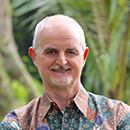From 1 November 2017, Dr. Robert Nasi is taking on the role of Director General of the Center for International Forestry Research (CIFOR). Dr. Nasi is no newcomer to CIFOR, having been with the Center for more than 20 years, holding a variety of research and senior management roles, most recently as Deputy Director General for Research. In conversation with Forests News, he speaks about his decades of experience with CIFOR and in tropical forestry research, and lays out plans for the future.
Watch the full interview here.
Good morning, Robert. You have been researching tropical forests for more than three decades now. They probably look very different. What has changed, in your opinion?
It’s not that the forests look different, it’s the way we look at forests that is different. The forest, the old-growth, primary part, has probably been reduced over the past 30 years. There is more secondary forest. But it’s more the way society looks at forests that has changed.
When I started my career, it was still much more about looking at forests as producing timber or goods, and now we have another ongoing evolution toward looking at ecosystem services, carbon storage, water, biodiversity. So I would say that it’s more the societal view and demand on forests that has changed, rather than the forests themselves.
So you have always had an interest in biodiversity, and forests contain about 50 percent of the biodiversity today. What should be the priorities there for scientists and researchers?
Well, I think there are two priorities. One is, we need to preserve as much as possible the area of forest that is still intact, that has been untouched – and untouched doesn’t mean that there is nobody inside, or people are not using it, but that we should avoid making real use of this and try to keep them as much intact as possible.
But more importantly, we should recognize the role of secondary forest in terms of biodiversity. There is considerably more biodiversity in secondary forest than in oil palm plantations. I think this is an important point because too often, people have the tendency to consider these secondary forests as ‘degraded’. And because they are degraded you can convert them into oil palm, pasture or rubber plantations. I think that’s very important, because now the area of secondary forest is bigger than the area of primary forest.
Can you talk about how the CIFOR strategy and priorities have evolved over time since you’ve been here?
CIFOR was created in 1993, and when it was created there were six people in the organization. At first, it was created with the idea that the main problem was not a technical problem, it was a policy and human problem. And so it was created with this idea of, we are going to really look at influencing policies in terms of the way forests are managed.
And then the first CIFOR strategy was developed in 1996, and this first strategy was mainly continuing this initial idea of looking at forestry issues, but forestry in a sense of a relatively narrow perspective, and in terms of what the policies are that influence forests, and we had the limitation at that time of looking at the humid tropics, and for the dry tropics, the Miombo Zambezian area.
So that was the first strategy. Then it evolved, and in 2008 there was a new strategy, which gave much more focus to the climate change agenda, to the importance of mitigation and adaptation, and that already started broadening the concept of forestry.
And now there is the new strategy, for 2016 to 2025, which really places forestry as a centerpiece to achieving the Sustainable Development Goals. So we have moved to become something which is different to the classical forestry sort of an organization, but still very much focused on forests, and on to something which is much broader an answer to the questions raised by the Sustainable Development Goals.
What are your priorities for CIFOR going forward?
Well, one of the very short-term priorities is probably ensuring that we have a good launch of the GLF in Bonn in December, and having a consultation with the staff to get their feeling on what should be done, on what needs to be done. We have also a meeting of the Board of Trustees in November — so these are the immediate priorities.
My longer-term priority is really to put CIFOR on a growth trajectory, and to make sure that we continue to deliver the relevant research, capacity development, outreach and engagement, to change the way forests and forestry are perceived, and, ultimately, make the world a better place.
The Global Landscapes Forum, which is led by CIFOR, has just received funding for the next five years from the Government of Germany. How do you see this platform evolving, and how can it make a difference?
It’s not as if it’s starting now, it’s the result of a long evolution from the time of the Forest Day, to what we can call the first ‘avatar’ of the Global Landscapes Forum. And now we are going toward something which is more than a very nice, significant event per year, but more, I think, about creating a platform. The overall goal of the new Global Landscapes Forum, which is about ‘reaching one billion’, is really about a transformational change in the way we conceive of landscapes, and the use of the resources that are linked to landscapes.
Wonderful. Thank you so much, Robert, for your time.
We want you to share Forests News content, which is licensed under Creative Commons Attribution-NonCommercial-ShareAlike 4.0 International (CC BY-NC-SA 4.0). This means you are free to redistribute our material for non-commercial purposes. All we ask is that you give Forests News appropriate credit and link to the original Forests News content, indicate if changes were made, and distribute your contributions under the same Creative Commons license. You must notify Forests News if you repost, reprint or reuse our materials by contacting forestsnews@cifor-icraf.org.









